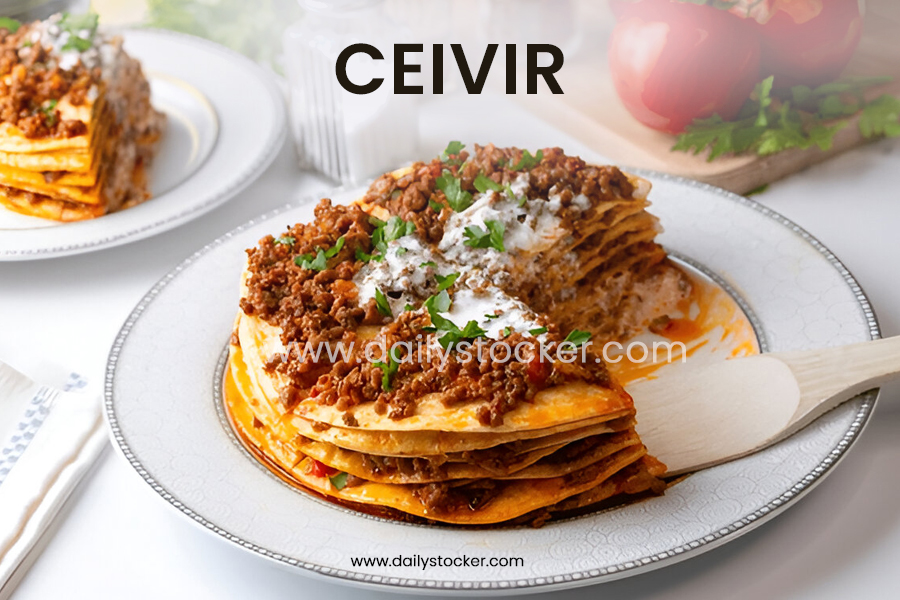Ceıvır: A Timeless Turkish Culinary Treasure Rooted in Tradition
Ceıvır is a traditional Turkish dish that beautifully represents the depth, warmth, and richness of Anatolian cuisine. Known for its savory flavors and deep cultural roots, ceıvır has been passed down through generations as both a comforting home-cooked meal and a celebratory dish. More than just food, ceıvır reflects community spirit, hospitality, and a connection to Turkish heritage.
In this article, we’ll explore everything you need to know about ceıvır — from its origins and preparation methods to its role in Turkish culture, health benefits, variations, and modern-day relevance. Whether you’re a food enthusiast eager to discover authentic flavors or someone planning to try ceıvır for the first time, this comprehensive guide will walk you through its story, flavors, and enduring charm.
What is Ceıvır?
At its core, ceıvır is a traditional Turkish specialty that involves marinated meat, often lamb or chicken, slow-cooked over an open flame or roasted until tender and flavorful. Unlike many quick recipes, ceıvır thrives on patience and tradition. Its preparation requires time, attention, and respect for age-old cooking techniques.
The name ceıvır itself is rooted in the Turkish word for “turn” or “rotate,” a direct reference to the way the meat is carefully roasted on a spit or skewered grill. This cooking style allows the meat to retain its juiciness while developing smoky, aromatic layers that delight the senses.
What makes it unique isn’t just its taste, but also the cultural value attached to it. In Turkish households and village gatherings, it is more than food — it’s a communal event that brings families and neighbors together, often during holidays, weddings, and festive celebrations.
The Origins and History of Ceıvır
The roots of ceıvır stretch back centuries, deeply intertwined with Turkey’s nomadic traditions and Anatolia’s diverse culinary influences. Historically, Turkish tribes relied on livestock farming, and meat dishes formed a central part of their diet. Cooking meat on skewers over an open fire was both practical and flavorful, making ceıvır a natural favorite.
Over time, it evolved into a dish not just for survival but also for celebration. As Ottoman culture flourished, culinary traditions blended flavors from Central Asia, the Middle East, and the Mediterranean, enriching the preparation of it with spices, marinades, and side dishes.
Today, it remains a symbolic dish at cultural events — often representing togetherness, abundance, and the joy of sharing meals. Its endurance proves how powerful food can be in preserving history and connecting people to their roots.
Ingredients That Define Ceıvır
The beauty of ceıvır lies in its simplicity. While variations exist depending on the region, certain core ingredients remain consistent:
- Meat: Traditionally lamb, though chicken and beef are also popular.
- Marinade: Olive oil, yogurt, garlic, onions, lemon juice, and a mix of spices such as cumin, paprika, and black pepper.
- Spices: Regional influences bring in fresh herbs like thyme, oregano, or sumac for extra depth.
- Sides: Flatbreads, rice pilaf, fresh salads, and roasted vegetables usually accompany it.
This balanced combination of protein, spices, and fresh accompaniments makes it both flavorful and nutritious.
The Traditional Method of Preparing It
Authenticity is key to understanding it. Unlike modern shortcuts, the traditional method requires patience and community participation:
- Selecting the Meat – High-quality cuts, often sourced fresh from local farmers, are preferred.
- Marinating – The meat is soaked for hours, sometimes overnight, in yogurt and spices to tenderize and enrich flavor.
- Roasting – Traditionally, it is roasted over an open flame or on a rotating spit, ensuring even cooking and smoky notes.
- Serving – Once cooked, the meat is thinly sliced and served hot with bread, rice, and sides.
This method, though time-consuming, ensures that it remains juicy, aromatic, and true to its origins.
Regional Variations of Ceıvır Across Turkey
One of the fascinating aspects of ceıvır is how its preparation changes from region to region. Turkey is a land of diverse climates, traditions, and agricultural practices, which influence local cuisines. While the core identity of ceıvır remains intact, each region adds its own twist to the recipe.
1. Anatolian Style
In central Anatolia, ceıvır is typically made with lamb, seasoned simply with salt, pepper, and a touch of yogurt-based marinade. Locals prefer to highlight the natural flavor of the meat without overwhelming spices.
2. Mediterranean Touch
Coastal areas, influenced by Mediterranean cuisine, incorporate olive oil, lemon, oregano, and fresh herbs into the marinade. This version of ceıvır is lighter, with a refreshing aroma that pairs beautifully with salads and grilled vegetables.
3. Eastern Spices
In eastern Turkey, ceıvır takes on a spicier personality. Chili flakes, sumac, and cumin dominate the marinade, giving the dish a bold and fiery kick. This variation often reflects the hearty appetites and strong flavors typical of the region.
4. Aegean Influence
The Aegean region is known for its emphasis on olive oil and fresh garden herbs. Ceıvır here is often paired with mezes (small side dishes) like hummus, baba ghanoush, and stuffed grape leaves, creating a balanced and colorful feast.
These variations highlight howe it adapts to local tastes while retaining its essence. No matter where you are in Turkey, ordering it feels like tasting the soul of that region.
Ceıvır as a Cultural Experience
Ceıvır is not just about what’s on the plate — it is also about the experience of making and sharing it. In Turkish culture, food plays a central role in hospitality and community life, and its a perfect example of this spirit.
- Family Gatherings: Preparing it is often a family affair. Elders marinate the meat, while younger members help set up the grill or prepare side dishes.
- Festivals & Weddings: During weddings, religious holidays like Eid, or harvest celebrations, large gatherings often include it as a centerpiece dish. The roasting process itself becomes part of the festivity, with music, dancing, and conversation happening around the fire.
- Symbol of Sharing: Offering ceıvır to guests is a gesture of respect and generosity. In Turkish tradition, sharing food is a way to strengthen bonds and celebrate togetherness.
Thus, enjoying ceıvır is more than just eating — it’s about participating in a cultural ritual that values friendship, community, and tradition.
Modern Adaptations of Ceıvır
While the traditional method of ceıvır involves open-fire roasting, modern lifestyles and urban living have led to new adaptations. These make it easier for people to enjoy ceıvır at home or in restaurants without compromising too much on flavor.
1. Oven-Baked Ceıvır
For city dwellers without access to open flames, oven-baked ceıvır is a practical alternative. Marinated meat is roasted slowly in the oven, often wrapped in foil to lock in juices, resulting in tender and flavorful bites.
2. Grill Pan Method
In smaller households, a grill pan on the stovetop can replicate the charred edges and smoky flavor of traditional ceıvır. While not identical to spit-roasting, it offers a delicious compromise.
3. Restaurant Innovation
Upscale Turkish restaurants have reimagined ceıvır by experimenting with gourmet touches — pairing it with wine, adding exotic marinades, or serving it as sliders and wraps for modern dining experiences.
4. Vegetarian Versions
Interestingly, some creative chefs have even introduced vegetarian versions of ceıvır using mushrooms, eggplant, or plant-based proteins marinated in traditional spices. These versions allow vegetarians and vegans to enjoy the spirit of ceıvır without meat.
These adaptations prove that ceıvır is timeless and versatile — able to maintain its identity while adjusting to contemporary needs.
Health Benefits of Ceıvır
Beyond its irresistible taste, ceıvır offers several nutritional benefits when prepared with fresh, quality ingredients.
- High in Protein: As a meat-based dish, ceıvır is an excellent source of protein, essential for muscle growth, repair, and overall energy.
- Rich in Healthy Fats: When made with olive oil and yogurt, ceıvır contains healthy fats that support heart health.
- Packed with Nutrients: Spices like cumin, paprika, and oregano add antioxidants and anti-inflammatory properties.
- Balanced Meal: Traditionally, ceıvır is served with vegetables, salads, and whole grains, creating a balanced plate that combines protein, fiber, and vitamins.
- Low in Processed Ingredients: Unlike fast food, authentic ceıvır relies on natural, fresh, and minimally processed ingredients, making it a healthier choice.
Of course, like any meat dish, portion control and cooking method matter. Avoiding excess oil and pairing ceıvır with fresh sides ensures a nutritious, well-rounded meal.
Serving Ceıvır the Turkish Way
Presentation is key when it comes to ceıvır. In Turkish households and restaurants, the dish is often served with a variety of accompaniments that transform it into a feast.
- Pide or Lavash Bread: Freshly baked bread is used to wrap slices of ceıvır, absorbing the meat’s juices and enhancing the experience.
- Rice Pilaf: A comforting side dish that balances the smoky richness of ceıvır.
- Fresh Salad: Tomato, cucumber, parsley, and onion salad add freshness and crunch.
- Pickles & Yogurt: Tangy pickles and creamy yogurt dip provide contrast to the roasted flavors.
- Traditional Drinks: Ayran (a yogurt-based drink) or Turkish tea often accompany the meal.
This serving style emphasizes balance — the smoky richness of the meat is complemented by refreshing sides, ensuring the meal feels complete and satisfying.
Ceıvır Around the World
Although ceıvır is deeply rooted in Turkish tradition, its appeal has crossed borders. Thanks to Turkish communities living abroad, this dish has traveled far and wide, gaining popularity in many countries.
1. Europe
In countries like Germany, France, and the Netherlands, Turkish immigrants introduced ceıvır decades ago. It often appears alongside döner kebab shops, though ceıvır maintains its more rustic and authentic flavor. Restaurants specializing in traditional Anatolian cooking proudly serve ceıvır as a specialty dish for those craving a taste of Turkey.
2. Middle East
In neighboring Middle Eastern countries, ceıvır resonates strongly because of its similarities to shawarma and other spit-roasted meats. However, Turkish ceıvır stands out for its yogurt marinades and balanced spice blends.
3. North America
With the global rise of food tourism, Turkish restaurants in cities like New York, Toronto, and Los Angeles have added ceıvır to their menus. Food bloggers and culinary influencers highlight it as a must-try dish for anyone exploring authentic Turkish food.
4. Asia-Pacific
In Australia and parts of Southeast Asia, ceıvır is enjoyed at cultural festivals and food markets. Its smoky aroma and hearty presentation make it a crowd-pleaser, often introduced as “Turkish-style roasted meat.”
This international journey proves that ceıvır isn’t just a dish — it’s a cultural ambassador that introduces the warmth of Turkish hospitality to the world.
Symbolism and Heritage of Ceıvır
Beyond its flavor, ceıvır carries symbolic meaning in Turkish life. It is tied to rituals of celebration, unity, and generosity.
- Hospitality: In Turkish culture, offering food is considered one of the highest forms of respect. Serving ceıvır to guests shows care and honor.
- Festive Symbol: At weddings, religious festivals, and harvest times, ceıvır often symbolizes abundance and blessings for the community.
- Connection to Ancestry: Preparing ceıvır the traditional way connects people to their ancestors, reminding them of simpler times when meals were cooked communally over fire.
Thus, ceıvır is not just a dish of the present but also a bridge to the past, carrying centuries of stories and traditions in every bite.
Step-by-Step Guide to Making Ceıvır at Home
For those inspired to try ceıvır at home, here’s a detailed recipe that stays true to tradition while being adaptable for modern kitchens.
Ingredients (Serves 4–6)
- 1.5 kg lamb (leg or shoulder, cut into chunks) or chicken thighs
- 1 cup plain yogurt
- 4 tbsp olive oil
- 1 large onion (grated)
- 4 cloves garlic (minced)
- Juice of 1 lemon
- 1 tsp cumin
- 1 tsp paprika
- 1 tsp black pepper
- 1 tsp salt
- Optional: chili flakes, oregano, or thyme
Preparation Steps
- Marinate the Meat
Mix yogurt, olive oil, onion, garlic, lemon juice, and spices into a smooth marinade. Coat the meat thoroughly, cover, and refrigerate for at least 6–8 hours (overnight is ideal). - Prepare the Cooking Setup
- Traditional Method: Skewer the meat and cook slowly over charcoal, rotating often.
- Home-Friendly Method: Preheat the oven to 180°C (350°F). Place marinated meat on a roasting tray or skewers and cover with foil for slow cooking.
- Cook Slowly
Roast for 1.5–2 hours, removing the foil in the last 20 minutes for a crispy, browned exterior. - Serve Hot
Slice thinly and serve with fresh bread, rice pilaf, salad, and yogurt dip.
Chef’s Tip
Basting the meat with its own juices halfway through cooking ensures maximum tenderness and flavor.
Common Mistakes to Avoid When Cooking Ceıvır
Even though ceıvır may look simple, there are common mistakes that can affect the final result. Here’s what to avoid:
- Skipping the Marinade Time
Rushing the marination process leads to dry and less flavorful meat. Overnight marination is best. - Using Too Much Heat
High flames can burn the outside while leaving the inside undercooked. Slow, even cooking is essential. - Not Resting the Meat
Cutting the meat immediately after roasting makes it lose its juices. Let it rest for 5–10 minutes before serving. - Overpowering with Spices
Ceıvır is about balance — too much chili or salt can overshadow the natural taste of the meat.
Avoiding these mistakes will help you achieve authentic, restaurant-quality ceıvır at home.
Ceıvır in Modern Pop Culture
Interestingly, ceıvır has also found its way into pop culture, food media, and global culinary conversations.
- Television Shows: Turkish dramas and cooking shows often highlight ceıvır as part of festive family scenes, making international viewers curious to taste it.
- Social Media Buzz: Food bloggers on Instagram, TikTok, and YouTube have embraced ceıvır, sharing recipes and cooking videos that attract millions of views.
- Tourism Campaigns: Turkish tourism boards frequently showcase ceıvır in promotional videos, presenting it as one of the country’s iconic foods visitors must try.
- Fusion Cuisine: Chefs abroad experiment with ceıvır in sandwiches, wraps, or even gourmet versions paired with wines and sauces.
This modern spotlight ensures that ceıvır remains relevant not only in Turkish homes but also in global food culture.
Why Ceıvır Stands Out Among Turkish Dishes
Turkish cuisine is vast and full of iconic dishes such as döner, kebab, börek, and baklava. Yet, ceıvır holds a special place for several reasons:
- It emphasizes slow cooking and patience, unlike fast street foods.
- It represents communal cooking traditions rather than individual portions.
- Its flavors are balanced and versatile, making it suitable for all ages.
- It carries a symbolic cultural weight, often reserved for meaningful occasions.
These qualities make ceıvır both a delicacy and a cultural symbol, distinguishing it from other popular dishes.
Ceıvır and Global Sustainability Goals
In today’s world, food is not only about taste but also about how it affects our planet. Ceıvır, when prepared in the traditional way, actually aligns with several sustainability values.
- Local Sourcing: Traditionally, families sourced meat from local farmers, reducing transportation impact and supporting small-scale agriculture.
- Minimal Waste: In Turkish households, every part of the meat is used — either in ceıvır or in accompanying soups and stews — reflecting a waste-conscious mindset.
- Balanced Eating: Ceıvır is always paired with bread, vegetables, and salads, promoting balance rather than overconsumption of meat.
- Eco-Friendly Cooking: Historically cooked over wood or natural charcoal, ceıvır relied less on industrial energy sources.
In an age when sustainability is a growing concern, these traditional practices offer lessons for modern cooking. By reviving authentic ceıvır preparation methods, we not only enjoy better flavors but also contribute to more responsible food habits.
The Future of Ceıvır in Turkish Cuisine
As Turkish cuisine continues to gain recognition worldwide, ceıvır holds a promising future. However, like many traditional dishes, it faces the challenge of adapting to modern lifestyles without losing authenticity.
1. Preservation Efforts
Cultural organizations in Turkey have started documenting regional recipes and cooking methods to ensure that ceıvır is preserved for future generations.
2. Youth Interest
Young chefs are rediscovering ceıvır, combining it with modern plating techniques and presenting it in creative ways at restaurants. This keeps the dish appealing to younger audiences.
3. Tourism Influence
With Turkey attracting millions of food-loving tourists each year, ceıvır has the potential to become as globally iconic as kebab or baklava. Culinary tours and cultural events often highlight ceıvır as a must-try dish.
4. Health-Conscious Adaptations
Given today’s focus on health, lighter versions of ceıvır (using lean cuts of meat, less oil, and more vegetables) are emerging. This allows health-conscious individuals to enjoy ceıvır without guilt.
The future of ceıvır looks bright — as long as it continues to balance tradition with innovation.
Conclusion — Why Ceıvır Deserves a Place on Your Table
Ceıvır is more than a dish — it’s a culinary story that connects past and present, family and community, tradition and innovation. Rooted in Turkey’s rich cultural heritage, ceıvır continues to capture hearts with its smoky aroma, tender texture, and symbolic value.
Whether enjoyed at a village festival, in a family home, or at a modern restaurant abroad, ceıvır carries with it the warmth of Turkish hospitality. Its ability to adapt to new lifestyles while preserving its authenticity makes it a timeless favorite.
If you’ve never tried ceıvır, consider this your invitation to explore it. Prepare it at home, order it at a Turkish restaurant, or add it to your culinary travel bucket list. One taste, and you’ll understand why ceıvır has stood strong for centuries — and why it will continue to shine as a symbol of tradition, togetherness, and delicious simplicity.
Don’t miss out on any news—keep in touch for real-time information, visit Daily Stocker.
Share this content:








Post Comment